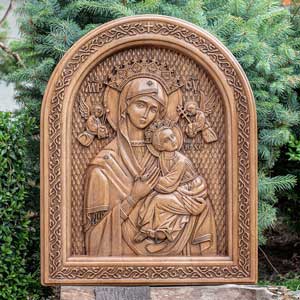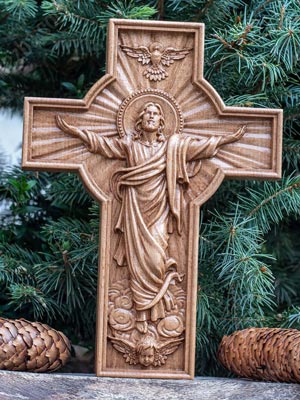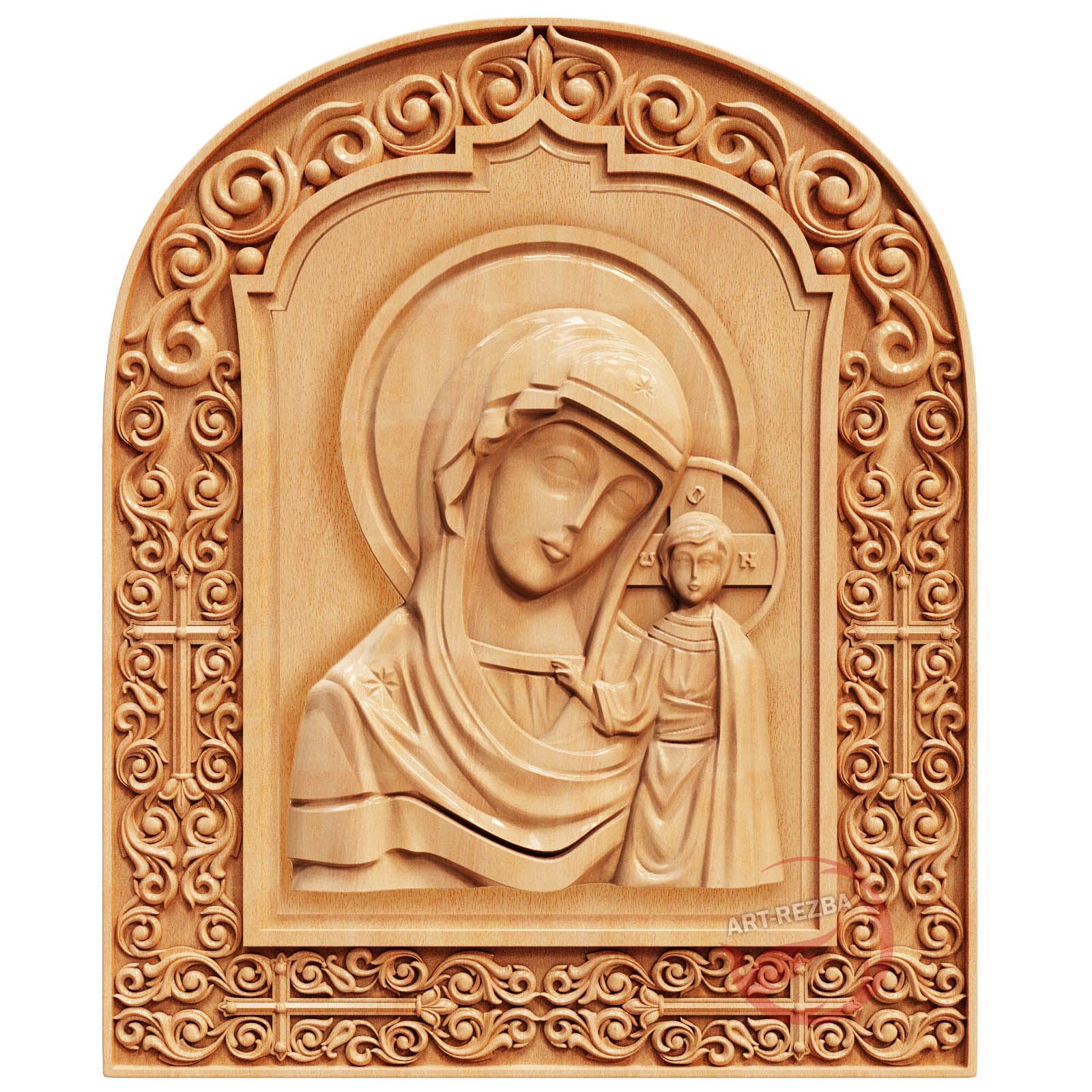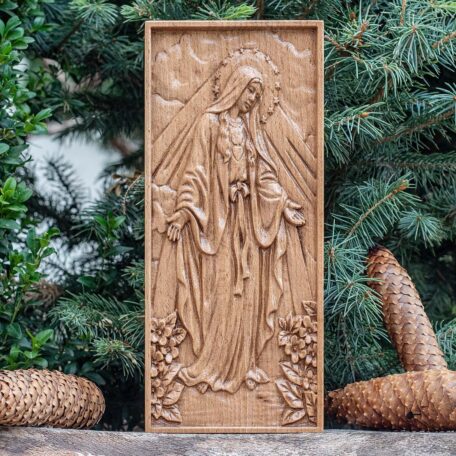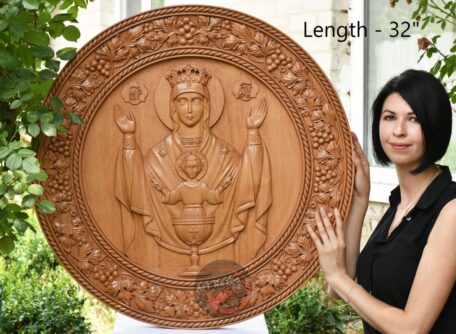Our Lady of Kazan
 Our Lady of Kazan, also called Mother of God of Kazan (Russian: Казанская Богоматерь tr. Kazanskaya Bogomater’), was a holy icon of the highest stature within the Russian Orthodox Church, representing the Virgin Mary as the protector and patroness of the city of Kazan, and a palladium of all of Russia, known as the Holy Protectress of Russia.
Our Lady of Kazan, also called Mother of God of Kazan (Russian: Казанская Богоматерь tr. Kazanskaya Bogomater’), was a holy icon of the highest stature within the Russian Orthodox Church, representing the Virgin Mary as the protector and patroness of the city of Kazan, and a palladium of all of Russia, known as the Holy Protectress of Russia.
According to legend, the icon was originally acquired from Constantinople, lost in 1438, and miraculously recovered in pristine state over 140 years later in 1579. Two major cathedrals, the Kazan Cathedral, Moscow, and the Kazan Cathedral, St. Petersburg, are consecrated to Our Lady of Kazan, and they display copies of the icon, as do numerous churches throughout the land. The original icon in Kazan was stolen, and likely destroyed, in 1904.
The “Fátima image” is a 16th-century copy of the icon, or possibly the 16th-century original, stolen from St. Petersburg in 1917 and purchased by F. A. Mitchell-Hedges in 1953. It was housed in Fátima, Portugal from 1970 to 1993, then in the study of Saint Pope John Paul II in the Vatican from 1993 to 2004, when it was returned to Kazan, where it is now kept in the Kazan Monastery of the Theotokos. Copies of the image are also venerated in the Catholic Church.
Feast days of Our Lady of Kazan are 21 July, and 4 November (which is also the Russian Day of National Unity).
The image of Our Lady of Kazan is said to have come to Russia from Constantinople in the 13th century. After the Tatars besieged Kazan and made it the capital of their khanate in 1438, the icon disappeared, and it is not mentioned again until the 16th century, some years after the liberation of Kazan by Ivan the Terrible in 1552.
After a fire destroyed Kazan in 1579, the Virgin appeared in a prophetic dream to a 10-year-old girl named Matrona and told her where to find the precious image again. As instructed, Matrona told the archbishop about her dream, but he would not take her seriously. After two more such dreams, on July 8, 1579, the girl and her mother themselves dug up the image, buried under the ashes of a house, where it had been hidden long before to save it from the Tatars. The unearthed icon looked as bright and beautiful as if it were new. The archbishop repented of his unbelief and took the icon to the Church of St. Nicholas, where a blind man was cured that very day. Hermogen, the priest at this church, later became Metropolitan of Kazan. He brought the icon to Kazan’s Cathedral of the Annunciation and established July 8 as a feast in honor of the Theotokos of Kazan. It is from Hermogen’s chronicle, written at the request of the tsar in 1595, that we know of these events.
By 1612, when Moscow was occupied by Polish invaders, Hermogen had become Patriarch of Moscow and All Russia. From prison, he called for a three-day fast and ordered the icon of Our Lady of Kazan to be brought to Princes Minin and Pozharsky, who were leading the resistance to the occupation. This icon—possibly the original, but more likely a copy—was carried before their regiments as they fought to regain the capital from the Poles. When the Polish army was finally driven from Moscow on October 22, 1612, the victory was attributed to the intercession of the Mother of God, and the Kazan icon became a focal point for Russian national sentiments. Later that year, when Tsar Mikhail Feodorovich came to the throne, he appointed both July 8 and October 22 as feasts in honor of Our Lady of Kazan.
The victorious Prince Dmitry Pozharsky financed the construction of a small wooden church dedicated to the Virgin of Kazan in the Moscow Kremlin. The icon was kept there until the small church burnt down in 1632. The tsar ordered the construction of a larger brick cathedral to replace it. After its completion in 1638, the icon remained there in Moscow’s Kazan Cathedral for nearly two centuries. It was regularly borne in solemn liturgical processions along the city walls as the protectress of Moscow. The intercession of Our Lady of Kazan was successfully invoked against a Swedish invasion in 1709, and again when Napoleon invaded Russia in 1812. To commemorate this latter victory, the Kazan icon was moved to the new Kazan Cathedral in St. Petersburg in 1821.
By this time, the Kazan icon had achieved immense popularity, and there were nine or ten separate miracle-working copies of the icon around the country. There is considerable disagreement about which of these, if any, was the original. Some claim the original remained housed in Kazan, while others hold that the one moved from Moscow to St. Petersburg was the original. Many experts, however, believe the original was lost and both of the venerated Kazan icons were early copies. In any case, both icons disappeared in the early 20th century. The one in Kazan was stolen in 1904 and probably destroyed by the thieves, who were more interested in its jeweled gold covering. The one in St. Petersburg disappeared after the October Revolution of 1917. Some say it was smuggled out of the country to protect it from the Bolsheviks, while others suggest the Communists themselves hid it and later sold it abroad. But during World War II, an icon of the Virgin of Kazan surfaced in Leningrad to lead a procession around the fortifications of the Nazi-besieged city.
The wonderworking icons Our Lady of Sitka and Our Lady of Soufanieh are both of the Kazan type.
Dear customers
This piece of wood carving would be perfect for your home or for present for your loved ones. This item is made from the high quality natural solid Beech wood.
The item’s finest details and it’s sizing are involved computer processing technology with manual tuning and the final details are finished by hand and coverage with ecological natural oil for wood.
Thickness of the item
Total thickness of the item between extreme points is 1-2,5 inches or 25-65 mm. Thickness is different for each item’s design and size.
The item comes with a detent on the back side to hang it on the wall.
Color can be little different
Every single item is a unique artwork and have different wood structure/color/weight from others.
Please remember that color can be little different from different screen reproduction, conditions of photography and natural color of the wood. Also note that for different sizes of the item, the detailization can be little different.
FAQ and Contact Us
Please read our FAQ to assist you in placing the order and additional information about our services and inventory.
If you still have any questions please Contact Us and we will gladly help.



